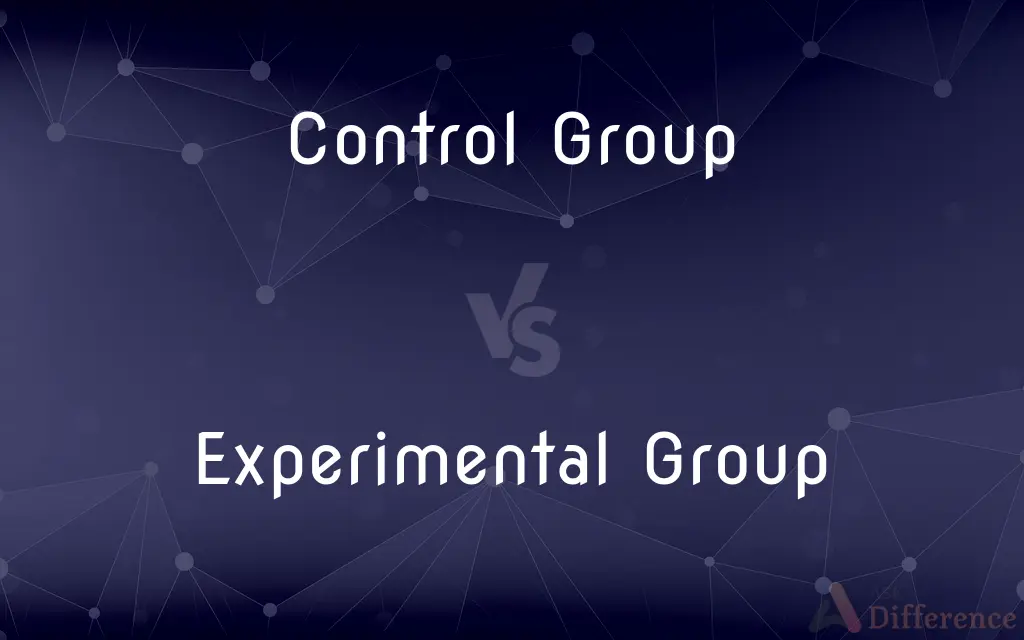Control Group vs. Experimental Group — What's the Difference?
By Maham Liaqat & Urooj Arif — Published on August 25, 2024
Control group serves as a baseline for comparison in experiments, receiving no treatment, while the experimental group is subjected to the treatment being tested, allowing researchers to evaluate the treatment's effect.

Difference Between Control Group and Experimental Group
Table of Contents
ADVERTISEMENT
Key Differences
The control group in scientific research acts as the baseline, providing data against which the effects of changes or interventions can be measured. This group does not receive the experimental treatment or is given a placebo, ensuring that any differences observed in the experimental group can be attributed to the treatment itself. On the other hand, the experimental group is subjected to the treatment or condition being tested. This allows researchers to directly assess the impact of the treatment by comparing the outcomes of the experimental group with those of the control group.
While the control group helps researchers understand what happens when the treatment is not applied, the experimental group provides insight into the treatment's actual effects. This comparison is crucial for establishing causality, enabling scientists to determine whether the treatment causes the observed outcomes. For instance, in a clinical trial for a new medication, the experimental group would receive the medication, whereas the control group might receive a placebo or an existing standard treatment.
The selection of participants for both groups is typically done through randomization to ensure that the groups are comparable in all respects except for the treatment. This minimizes bias and increases the reliability of the experiment's results. The experimental group's outcomes are then measured and compared with those of the control group to evaluate the treatment's effectiveness.
The methodology involving control and experimental groups is widely used across various fields, including medicine, psychology, biology, and social sciences. It is a fundamental aspect of the scientific method, ensuring that research findings are valid, reliable, and applicable to broader contexts.
Choosing the right control group is as important as defining the experimental treatment. In some cases, researchers use a "negative control group" that receives no treatment and a "positive control group" that receives a treatment with a known outcome. This helps in further validating the experimental results by providing additional points of comparison.
ADVERTISEMENT
The distinction between control and experimental groups underscores the importance of rigorous experimental design. By carefully controlling variables and ensuring that the only significant difference between the groups is the treatment, researchers can confidently attribute differences in outcomes to the treatment rather than to other factors.
Comparison Chart
Purpose
To serve as a baseline for comparison, not receiving the experimental treatment.
To receive the experimental treatment being tested.
Outcome Measurement
Used to understand the natural progression or placebo effect.
Assesses the actual impact of the treatment.
Selection
Randomly assigned to ensure comparability with the experimental group.
Also randomly assigned to eliminate selection bias.
Treatment
Receives no treatment or a placebo.
Receives the treatment or intervention being studied.
Significance
Helps in establishing a cause-effect relationship by providing a baseline.
Demonstrates the direct effects of the treatment on the participants.
Example Use
In drug trials, might receive a sugar pill as a placebo.
In the same trials, would receive the actual drug being tested.
Outcome Analysis
Differences in outcomes between this and the experimental group indicate treatment effect.
Outcomes are directly attributed to the treatment's efficacy or lack thereof.
Compare with Definitions
Control Group
Typically receives no treatment or a placebo to mimic the experimental conditions without the actual treatment.
The control group might take a sugar pill that looks identical to the diet pill but has no active ingredients.
Experimental Group
Like the control group, members are randomly selected to ensure the group is representative and comparable.
Random assignment ensures that the experimental group is similar in key aspects to the control group before the study begins.
Control Group
To isolate the treatment's effects by providing a comparison against the experimental group's outcomes.
By comparing the placebo group to those taking the actual diet pill, researchers can determine if weight changes are due to the pill.
Experimental Group
To determine the treatment's direct effects by observing changes in this group compared to the control group.
Any significant weight loss in this group compared to the control group suggests the diet pill may be effective.
Control Group
A group in an experiment that does not receive the treatment being tested, used as a baseline for comparison.
In a study on a new diet pill, the control group receives a placebo to compare the effects of the pill on weight loss.
Experimental Group
Provides evidence of the treatment's efficacy or lack thereof by being directly compared to the control group.
If the experimental group loses more weight than the control group, the pill's effectiveness is supported.
Control Group
Members are chosen through random assignment to ensure similarity with the experimental group, minimizing bias.
Participants are randomly divided into control and experimental groups to ensure both groups are statistically similar at the start.
Experimental Group
Receives the actual treatment or intervention being studied.
Receives the diet pill under investigation to determine its impact on weight loss.
Control Group
Essential for validating the experiment's results by showing what happens in the absence of the treatment.
If both groups lose the same amount of weight, the diet pill is likely ineffective.
Experimental Group
The group in an experiment that receives the treatment or intervention being tested.
In the diet pill study, this group receives the actual pill to assess its effectiveness on weight loss.
Common Curiosities
Why is a control group necessary?
It provides a comparison point to determine if changes in the experimental group are due to the treatment or other variables.
Can an experiment have multiple experimental groups?
Yes, some experiments have multiple experimental groups to test different treatments or treatment levels against a single control group.
How do researchers ensure the groups are comparable?
Through random assignment and ensuring that the groups are similar in key demographics and characteristics before the experiment starts.
What is an experimental group?
The experimental group is the group in an experiment that receives the treatment or intervention being studied.
What is a placebo?
A placebo is a harmless substance given to the control group in medical trials to mimic the experimental treatment without therapeutic effects.
How is the effectiveness of the treatment measured?
By comparing the outcomes between the experimental and control groups, researchers can measure the treatment's effectiveness.
What is a double-blind study?
In a double-blind study, neither the participants nor the researchers know who is in the control or experimental group until the study concludes.
Why is randomization important in assigning groups?
It minimizes bias and ensures that the groups are similar in all respects except for the treatment being tested.
What is a control group?
A control group is a baseline group in an experiment that does not receive the treatment or intervention being tested.
How are participants assigned to each group?
Participants are typically assigned randomly to either the control or experimental group to minimize bias and ensure comparability.
What happens if there's no difference between the control and experimental groups?
If there's no significant difference, it may indicate that the treatment has no effect or the experiment needs to be redesigned.
How do researchers deal with variables other than the treatment?
They attempt to control or account for other variables through study design and statistical analysis to isolate the treatment's effects.
Can the control group receive a standard treatment instead of a placebo?
Yes, in some studies, the control group receives a standard treatment to compare the new treatment against the current standard.
What is the significance of the placebo effect?
The placebo effect shows that participants can experience changes simply because they believe they are receiving a treatment, highlighting the importance of control groups.
What ethical considerations are involved in using control groups?
Ethical considerations include ensuring that participants are not harmed and are fully informed about the study, including any use of placebos.
Share Your Discovery

Previous Comparison
Foaming Cleanser vs. Hydrating Cleanser
Next Comparison
Charcoal vs. BlackAuthor Spotlight
Written by
Maham LiaqatCo-written by
Urooj ArifUrooj is a skilled content writer at Ask Difference, known for her exceptional ability to simplify complex topics into engaging and informative content. With a passion for research and a flair for clear, concise writing, she consistently delivers articles that resonate with our diverse audience.













































